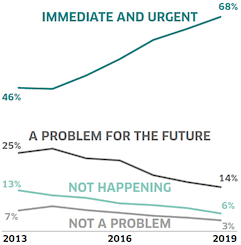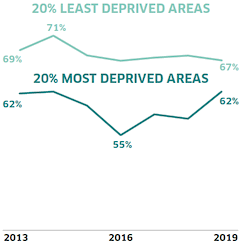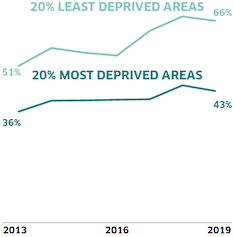Scottish household survey 2019: key findings
An infographic summary of the key findings from the 2019 edition of the Scottish Household Survey, a continuous survey running since 1999 based on a sample of the general population in private residences in Scotland.
Section Ten - Environment
7 in 10 adults in Scotland, or 68%, agreed that climate change was an immediate and urgent problem.
This was an increase by 4 percentage points since 2018, and by 23 percentage points since 2013.
This increase had been most prominent among adults aged 16 to 24, from 38% in 2013 to 69% in 2019.
Only 14% of adults believed that climate change was a problem for the future, a decrease from 25% in 2013.
Adults with a higher educational qualification or who live in a less deprived area were more likely to agree that climate change was immediate and urgent.

This graph shows the proportion of adults in the most and least deprived areas living within five minutes walking distance from an open green or blue (water) space, and how this changed between 2013 and 2019. It highlights that more people in the least deprived areas lived within five minutes of a green or blue (water) space, but that more people in the most deprived areas lived within a five minute walk from an open green or blue (water) space in 2019 than in 2016.
This line graph shows perceptions of climate change, and how they changed between 2013 and 2019. In order of how common these views were, it lists the options climate change is “immediate and urgent”, “a problem for the future”, “not happening”, and “not a problem”. It highlights that the majority of adults agreed that climate change was immediate and urgent, and that an increasing proportion of people had been thinking this since 2013.
The majority of adults in all age groups recognised climate change as an immediate and urgent problem
Among adults aged 75 and over, this number had increased from 46% in 2018 to 56% in 2019.
66% of adults in Scotland lived within a five minute walk from an open green or blue (water) space.
This was a significant decrease from 2013, when 68% of adults fell in this category.
However, this looked different depending on the level of deprivation of the household area.
For adults in the 20% most deprived areas, the proportion who are within a five minute walk of a green or blue space had increased from 55% in 2016 to 62% in 2019.
However, for adults in the least deprived areas the proportion had decreased from 71% in 2014 to 67% in 2019.

This graph shows the proportion of adults in the most and least deprived areas living within five minutes walking distance from an open green or blue (water) space, and how this changed between 2013 and 2019. It highlights that more people in the least deprived areas lived within five minutes of a green or blue (water) space, but that more people in the most deprived areas lived within a five minute walk from an open green or blue (water) space in 2019 than in 2016.
Adults in less deprived areas were more likely to say that they were satisfied with their nearest green or blue (water) space
A larger proportion also used their nearest green or blue (water) space more frequently
56% of adults visited the outdoors at least once per week in 2019.
This was a decrease since 2018, when 59% of adults visited the outdoors once per week or more.
However, it was still an overall increase since this data first was collected in 2013, when 46% of adults visited the outdoors once per week or more.
Adults living in the 20% least deprived areas visited the outdoors more frequently than those in the 20% most deprived areas.
This proportion was also increasing more in the least deprived areas, meaning that the difference had increased from 15 percentage points in 2013 to 23 percentage points in 2019.

This line graph shows the proportion of adults in the most and least deprived areas in Scotland who visit the outdoors at least once per week, and how this has changed between 2013 and 2019. It highlights that adults living in the least deprived areas were more likely to visit the outdoors at least once per week, and that this proportion had increased since 2016.
Adults in rural areas are more likely to visit the outdoors
64% of adults in rural areas visited the outdoors once per week or more, compared to 54% of adults in urban areas
Contact
Email: shs@gov.scot
There is a problem
Thanks for your feedback